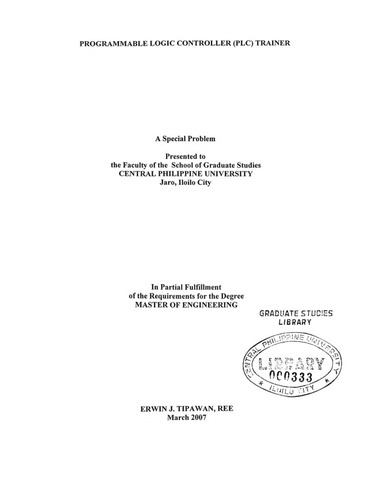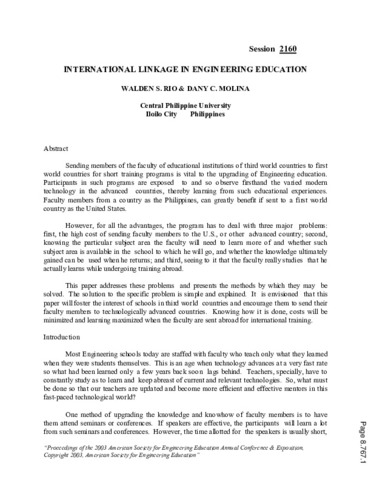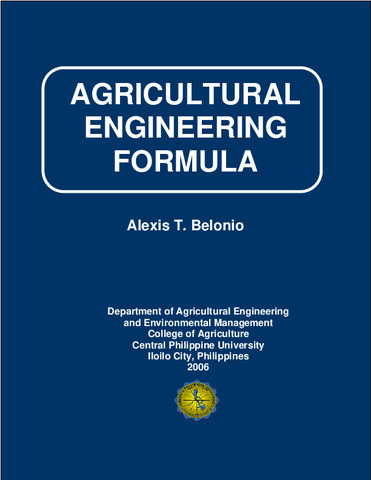Programmable logic controller (PLC) trainer

Page views
1,687Date
2007Author
Thesis Adviser
Defense Panel Chair
Share
Metadata
Show full item record
Abstract
The Western Visayas College of Science and Technology College of Engineering and Architecture as an educational institution offering electrical, electronics and communications engineering requires upgrading of its laboratory equipment. One of the equipment necessary is the Programmable Logic Controller (PLC). The school already purchased a PLC unit for its utilization. However, it needs a trainer modular panel for it to be used as an instructional device.
The study aims to design and construct a Programmable Logic Controller (PLC) trainer for instructional purposes. Specifically, the study aims to develop a trainer that can perform thirty (30) experiments which can be integrated with the existing motor control trainer.
The trainer is developed to contribute and satisfy the need for a learning device that would make laboratory experiments stimulating and interesting. Moreover, is expected to trigger efforts from the researcher, students, and other laboratory instructors to use the device to derive maximum benefits at a minimal cost and time.
The design of this PLC trainer was based on the concept of constructing a trainer that would simulate hard-wiring and soft-wring applications used in most industry setting. The PLC and other components of the trainer are mounted on a suitcase which acts also as its storage casing. It was done for the purpose of mobility and customization.
The Programmable Logic Controller device used was the Siemens S7-200 CPU 222 AC/DC/relay 8inputs, 6 outputs PLC. A 230 V AC power supply terminal was installed and provided with a 2 A fuse for protection and a power switch with LED for control.
STEP 7—Micro/WIN software was selected as the programming software since it is the requirement for any S7 200 PLC. An installer CD was purchased together with the PLC unit and can be installed to any available PC unit. Minimum requirement for the PC are:
1.) Windows 2000, Windows XP operating system;
2.) at least 100 MB free disk space; 3.) USB port;
3.) mouse (recommended).
A Simatic micro motor was installed as an added feature for output testing and simulation of motor control. The micro-motor was included in the purchase of the unit.
The PLC trainer is unique because all terminals were installed to simulate the installation, programming and wring of the PLC and field devices both the input and the outputs. This was done for the experiments to be stimulating and for students to perform well with less supervision.
Based on results and tests conducted on the trainer, a total of thirty (30) experiments were performed with positive outcome. It also showed additional experiments and activities can be developed and be derived. It was also observed that the trainer can be used and operated by the students with less supervision from the instructor.
The trainer can also be used together with the motor control trainer which contributed to the additional experiments that can be performed. The components of the PLC trainer and Motor Control trainer were also compatible. No major problems were encountered during testing and operation of the trainer.
The following conclusions can be given. The trainer performed thirty experiments, therefore can be used as an instructional device. The components and parts of the PLC trainer and the Motor Control trainer showed compatibility, therefore can be integrated and used together in performing several experiments. The trainer required also proper background for the user in terms of its parts, operation and programming to have a sufficient working background.
Based on the conclusions drawn, it is recommended that: The PLC trainer should be adopted as an instructional device for various engineering subjects involving motor control, logic, programming, and control systems. As a pre-requisite, proper background and introduction should be made to the user before the trainer can be operated. In this connection a user’s manual should be developed and introduced. Formulation of modules/experiment manuals should be encouraged for every faculty that would utilize the trainer. Instructors should be encouraged to construct and improve the model using other electronic and or mechanical device for advancement of instructional process in electrical engineering.
A relay should be installed in the output module of the PLC to isolate the PLC from the direct connection to the output device utilized. The findings of the study must be published so that other institution would be informed of its viability. Financial support from government and non-government agency for the mass production of the trainer should be promoted. A replication of this study should be made using another sample in a different setting.
Description
Abstract only
Suggested Citation
Tipawan, E.J. (2007). Programmable logic controller (PLC) trainer (Unpublished Master's special paper). Central Philippine University, Jaro, Iloilo City.
Type
Special paperSubject(s)
Keywords
Department
School of Graduate StudiesDegree
Master of Engineering major in Electrical EngineeringShelf Location
GSL Theses 6620.0072 T499
Physical Description
xi, 63 leaves
Collections
Related items
Showing items related by title, author, creator and subject.
-
A proposal for the acquisition of an Agilent 1100 series HPLC system
Dumam-ag, Sharon Rose G. (2006)This study aimed to put into proper perspective the importance of acquiring a High Performance Liquid Chromatography (HPLC) for the Department of Chemical Engineering of CPU through the help of alumni and friends who have ... -
International linkage in engineering education
Rio, Walden S.; Molina, Dany C. (American Society for Engineering Education, 2003-06-22)Sending members of the faculty of educational institutions of third world countries to first world countries for short training programs is vital to the upgrading of Engineering education. Participants in such programs are ... -
Agricultural engineering formula
Belonio, Alexis T. (Central Philippine University, 2006)This book is a compilation of the various formula that are commonly used in agricultural engineering curriculum. Students who are taking the course as well as those who are preparing for the Professional Agricultural ...




